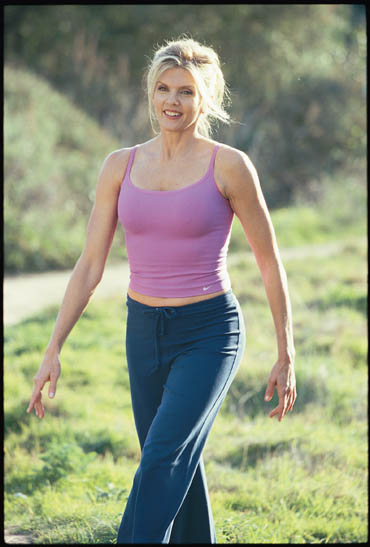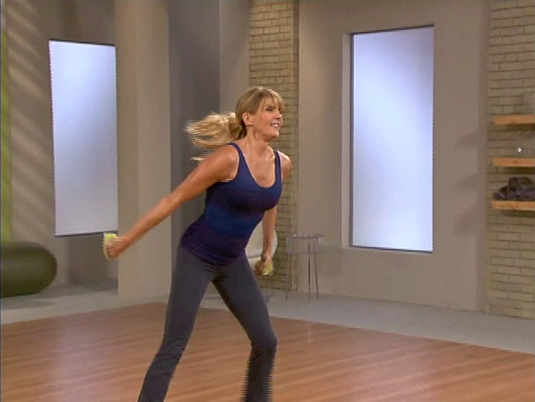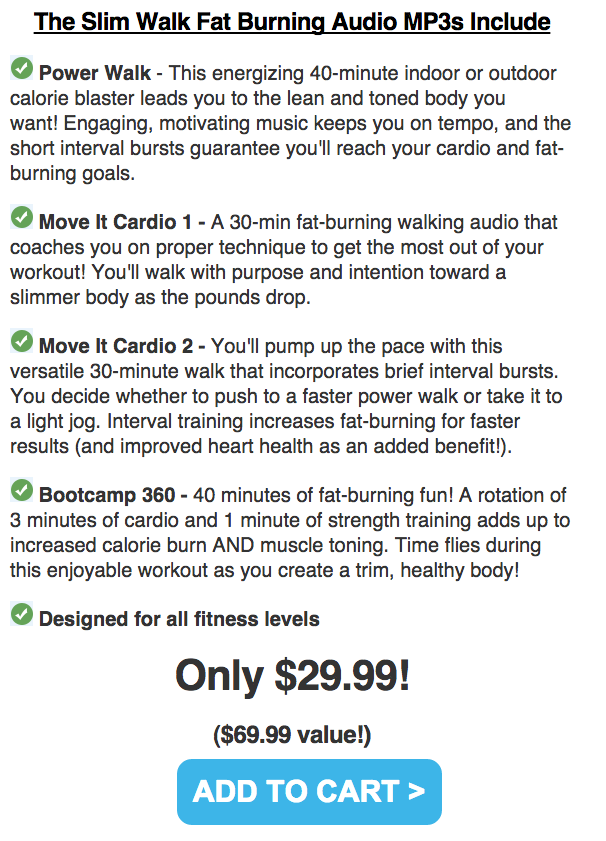 Walking seems to be a wonder drug with virtually no side effects. It’s incredibly simple, astonishingly powerful, and study after study proves that by tying up your laces for even just a few minutes a day can transform your body, mind and health. I’ve had thousands of women and men tell me how my walking programs and techniques have transformed their bodies and changed their lives. Take a minute to watch this short video of some incredible success stories:
Walking seems to be a wonder drug with virtually no side effects. It’s incredibly simple, astonishingly powerful, and study after study proves that by tying up your laces for even just a few minutes a day can transform your body, mind and health. I’ve had thousands of women and men tell me how my walking programs and techniques have transformed their bodies and changed their lives. Take a minute to watch this short video of some incredible success stories:
- Two hours of walking each week can reduce your risk of stroke by 30%
- Brisk walking for 75 minutes a week can add almost two years to your life
- A one-hour walk daily can cut your risk of obesity in half!
Whether you’re super fit, overweight, or somewhere in between, you can improve your health with walking…the easiest, most natural exercise in the world. Even if like Ellen in the video above, you have 55 lbs to lose, walking can help you reach your goals, but only if you follow the 4 tricks below. But before we begin, let’s talk about speed. Weight loss walking is about increasing speed by taking more smaller steps per minute, not by taking bigger steps But moving your legs that quickly in a walk takes an enormous amount of effort. In fact, at 5 mph, it’s much more efficient to run — and cover more ground with each stride — than it is to walk. So you actually use more energy, and burn more calories walking a 12-minute mile than running a 12-minute mile. Here are 4 tips to help you crank up your speed and increase your caloric burn:
1. Interval training
The best way to learn to walk this fast is to practice for short stretches, with reset periods at a slower pace in-between. This is called “interval training” and it has some really fantastic benefits of its own. By alternating intervals of high-intensity effort with recovery periods, your heart, lungs, and muscles can work harder for shorter spurts than they could work continuously. Start with 30-second intervals of high-intensity walking, with 30 seconds of recovery in between. These high-intensity intervals can dramatically improve your overall stamina. Eventually, you’ll be able to maintain that high-intensity pace for longer and longer periods of time. Here’s a sample fat-blasting interval walking workout:
30-Minute Fat-Burning Walk
• 5 minute Warm-Up Pace
• 3 minute Aerobic Interval – Push yourself slightly more than your steady-state pace
• 3 minute Recovery Interval – Catch your breath and get ready for the next interval!
• 3 minute Aerobic Interval
• 3 minute Recovery Interval
• 1 minute Anaerobic Interval – For one minute, walk as fast as you possibly can! On a scale from 1-10, you should be pushing yourself to between 7-9.
• 3 minute Recovery Interval
• 1 minute Anaerobic Interval
• 3 minute Recovery Interval
• 1 minute Anaerobic Interval
• 3 minute Recovery Interval
• 5 minutes Cool-Down Pace
2. Walk the line
 To increase your walking speed, try to make your feet land one in front of another (rather than walking with them parallel), so you’re walking in a straight line. Now you’ll need to add imagination into the mix. If you were walking on an actual line, just the inside of your foot (the instep) would touch the line: Your feet shouldn’t cross over. Check yourself by walking an actual line: a painted lane line on a track or a crack in the pavement, for example. Feel the rhythm you’re creating? “Walking the line” forces you to rotate your pelvis and extend your hips slightly, which lengthens your stride a little. At faster speeds, you’ll get some front-to-back rotation in your pelvis. Don’t consciously try to waggle your hips or exaggerate the motion, let your body move naturally. Just align your footsteps, leading with your heels, and stay loose in your pelvis as your hips follow where your legs lead. A note to men: Since you have less hip swivel in your normal walking gait than women do, this technique can be more difficult for you. Make a conscious effort to stay loose in your hips and let your pelvis rotate.
To increase your walking speed, try to make your feet land one in front of another (rather than walking with them parallel), so you’re walking in a straight line. Now you’ll need to add imagination into the mix. If you were walking on an actual line, just the inside of your foot (the instep) would touch the line: Your feet shouldn’t cross over. Check yourself by walking an actual line: a painted lane line on a track or a crack in the pavement, for example. Feel the rhythm you’re creating? “Walking the line” forces you to rotate your pelvis and extend your hips slightly, which lengthens your stride a little. At faster speeds, you’ll get some front-to-back rotation in your pelvis. Don’t consciously try to waggle your hips or exaggerate the motion, let your body move naturally. Just align your footsteps, leading with your heels, and stay loose in your pelvis as your hips follow where your legs lead. A note to men: Since you have less hip swivel in your normal walking gait than women do, this technique can be more difficult for you. Make a conscious effort to stay loose in your hips and let your pelvis rotate.
3. Speed up the arm swing
Swing those arms as if you’re the grand marshal in a parade! You can really add to your forward momentum — and get some significant upper-body exercise — by pumping your arms more quickly. As you start to go a little faster, your arms will swing across your body slightly, and that’s okay. Just focus on the joy of the movement and the extra fuel you’re burning!
4. Squeeze your glutes
Your gluteals are the muscles in your butt, just above your hamstrings. At the end of each stride, as you’re pushing off with your toes, squeeze the gluteals in the same leg. This helps draw the leg back, which increases your speed and develops the muscles that will help reverse a drooping backside.




